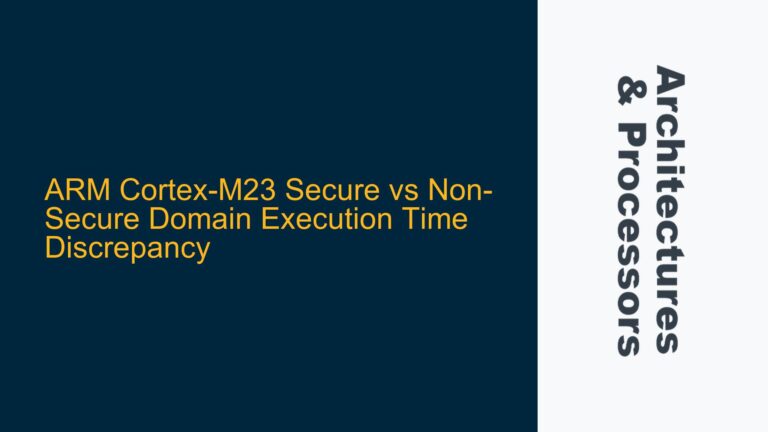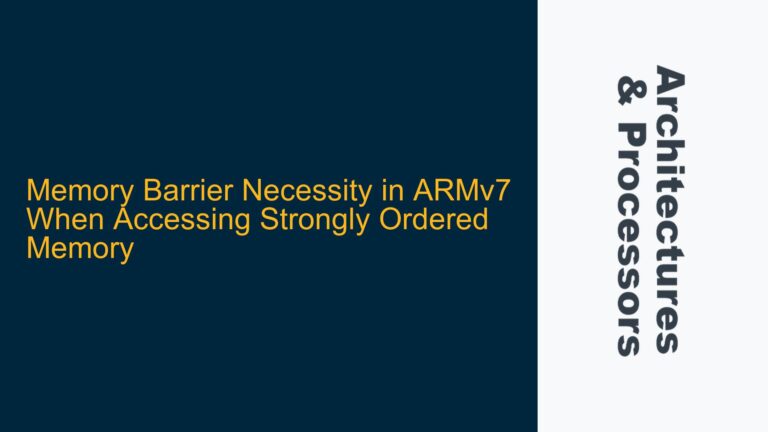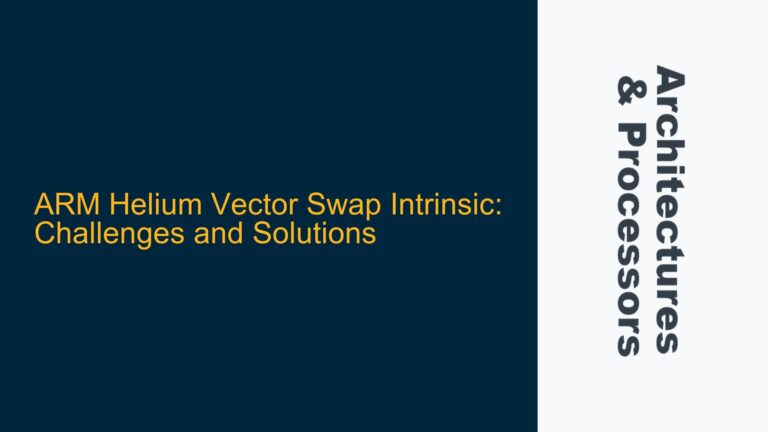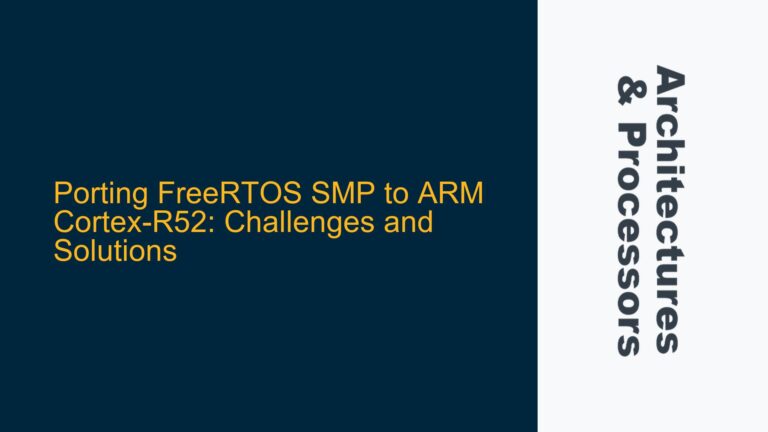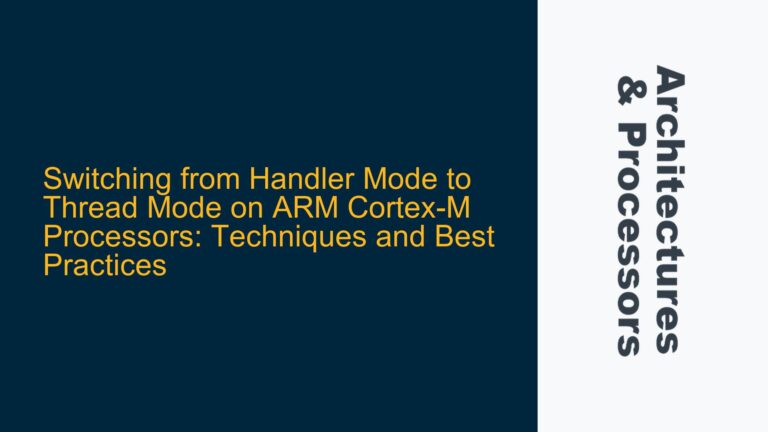ARM MMU Page Table Linking Constraints with Absolute Addressing
The ARM Memory Management Unit (MMU) is a critical component in modern ARM architectures, responsible for translating virtual addresses to physical addresses. This translation is facilitated through a hierarchical page table structure, where Level 1 (L1) page table entries point to Level 2 (L2) page tables. A key constraint in this architecture is that the L1 page table entries must contain absolute physical addresses (PAs) or Intermediate Physical Addresses (IPAs) for the L2 page tables. This requirement poses a significant challenge during system initialization, particularly when page tables are generated at compile time or before runtime, as the exact physical addresses of the L2 page tables may not be known in advance.
The issue arises because the MMU hardware expects these addresses to be absolute, not relative. This means that any attempt to use relative addressing—where the address of the L2 table is specified as an offset from the base address of the L1 table—will fail. The MMU does not support such relative addressing schemes, and attempting to implement them will result in incorrect address translations, leading to memory access violations, data corruption, or system crashes.
This constraint is particularly problematic in scenarios where the memory layout is not fixed at compile time, such as in dynamically allocated memory systems or when using advanced programming languages like Zig, which emphasize compile-time features but lack access to hard-linked label addresses during compilation. In such cases, developers must find alternative methods to ensure that the page table entries contain valid absolute addresses before the MMU is enabled.
Dynamic Memory Allocation and Linker Script Limitations
The inability to use relative addressing in ARM MMU page tables is often exacerbated by the way memory is allocated and managed in embedded systems. In many cases, the memory for page tables is dynamically allocated at runtime, making it impossible to determine the absolute addresses of these tables at compile time. This is especially true in systems that use advanced memory management techniques, such as heap allocation or memory pools, where the exact location of the allocated memory is not known until runtime.
Additionally, linker scripts, which are commonly used to define memory layouts in embedded systems, may not provide sufficient flexibility to resolve this issue. While linker scripts can define memory regions and assign symbols to specific addresses, they typically operate at a coarse granularity and may not be able to handle the fine-grained address requirements of MMU page tables. This is particularly true in systems with complex memory hierarchies or multiple memory regions, where the linker script may not have enough information to generate the required absolute addresses for the page tables.
Furthermore, the use of advanced programming languages like Zig, which emphasize compile-time features and metaprogramming, can introduce additional complexities. In Zig, the comptime feature allows for compile-time execution of code, but it does not provide access to hard-linked label addresses. This means that developers cannot use compile-time features to generate absolute addresses for page tables, forcing them to resort to runtime solutions or workarounds.
Implementing Runtime Address Resolution and Page Table Initialization
To address the challenges posed by the ARM MMU’s requirement for absolute addresses in page table entries, developers must implement runtime solutions that resolve the addresses of the L2 page tables and initialize the L1 page table entries accordingly. This process typically involves several steps, including memory allocation, address resolution, and page table initialization.
First, the memory for the page tables must be allocated at runtime. This can be done using standard memory allocation functions, such as malloc or custom memory pool allocators, depending on the system’s requirements. Once the memory is allocated, the absolute addresses of the L2 page tables can be determined by querying the memory allocator or using pointer arithmetic to calculate the addresses relative to the base address of the allocated memory.
Next, the L1 page table entries must be initialized with the absolute addresses of the L2 page tables. This can be done by iterating over the L1 page table and setting the appropriate entries to point to the corresponding L2 page tables. Care must be taken to ensure that the addresses are correctly aligned and that the page table entries are properly formatted according to the ARM architecture’s requirements.
Finally, the MMU must be enabled, and the page tables must be activated. This typically involves setting the appropriate control registers in the ARM processor, such as the Translation Table Base Register (TTBR), and enabling the MMU by setting the appropriate bits in the System Control Register (SCTLR). Once the MMU is enabled, the processor will use the page tables to translate virtual addresses to physical addresses, and the system will be able to operate normally.
In systems that use advanced programming languages like Zig, additional steps may be required to integrate the runtime address resolution and page table initialization process with the language’s compile-time features. This may involve using Zig’s comptime feature to generate the necessary data structures or functions at compile time, while deferring the actual address resolution and page table initialization to runtime. By carefully designing the system’s memory management and initialization routines, developers can overcome the limitations imposed by the ARM MMU’s requirement for absolute addresses and ensure that the system operates correctly.
Conclusion
The requirement for absolute addresses in ARM MMU page table entries presents a significant challenge for developers, particularly in systems where the memory layout is not fixed at compile time. By understanding the constraints imposed by the ARM architecture and implementing runtime solutions for address resolution and page table initialization, developers can overcome these challenges and ensure that their systems operate correctly. Whether using traditional C-based approaches or advanced programming languages like Zig, careful design and implementation of the memory management and initialization routines are essential for success.

